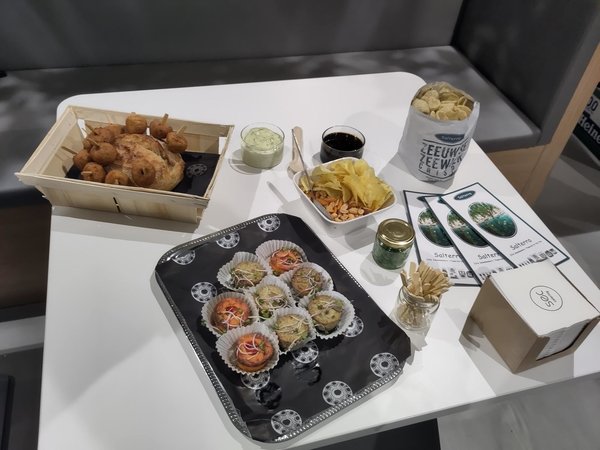Large companies in Europe: ‘Start with using seaweed today’
2022-12-12
How can we scale-up seaweed farming on the North Sea in a co-use setting with offshore wind farms? That was one of the main questions the six partners of Interreg Grensregio Wier &Wind project 'The Seaweed Company', 'Murre Technologies', 'Hogeschool Zeeland', 'Universiteit Gent', 'Geoxyz' and 'North Sea Farmers' tried to answer. For that they performed a seaweed cultivation pilot on the Offshore Test Site, 12 kilometers off the coast of The Hague, that was completed last summer.
Friday 2th of December the project was finalized with an event in the Hogeschool Zeeland (HZ) in Middelburg, combined with the community event of North Sea Farmers. Members and stakeholders from the seaweed sector came to the aquaculture region of The Netherlands to learn more about the prospects of seaweed cultivation in multi-use settings.
A range of speakers presented their best lessons learned: Michiel Mol of The Seaweed Company shared how he, in close collaboration with University Gent and Murre Technologies designed a production system suitable for offshore conditions. Gabrielle Verbeeke (HZ) monitored and analyzed the seeding process and seaweed growth at the open sea for 4 different net types. Jan Murre from Murre Technologies showed the Easy Farm Harvesting Machine that was redesigned for harvesting of seaweed and tested successfully on the Offshore Test Site.

Limits of scaling up
Keynote speaker Klaas Timmermans (NIOZ) took the audience along the potential environmental impacts to be taken into account when scaling-up seaweed production. He showed that scaling-up is definitely possible and given the anticipated (limited) size of the sector until 2030 there will most likely not be any major issues concerning nutrient availability. After that, when you really move towards large scale, you have to take into account the limits of the ecosystem in your plans and/or consider technological advancements to mitigate any adverse effects on the marine environment.
Bram de Kort (Director Interreg Grensregio) expressed his appreciation for the Wier&Wind project and invited new seaweed projects to consider the Interreg Grensregio program for funding opportunities. Nico Buytendijk (RVO) talked about the developments of multi-use from the (Dutch) regulatory point of view and the collaboration between B-NL on the concept of a Maripark.

Interactive roadmap
The day ended with an interactive session, and a glimpse at the future of the seaweed sector with an interactive roadmap, created by Klaas Jan Wardenaar from Smartland, that shows the various impacts associated with an anticipated growth of the sector develop over time. This was used a basis for discussion with all (online) participants on what targets we should set ourselves as a seaweed sector, the results of which will be shared with NSF members.
In conclusion, it was a vibrant and exciting day with the Wier&Wind partners showing that mechanised offshore seaweed cultivation is possible, although there are still many challenging steps to be taken. Nevertheless, (larger) companies that are currently holding back until there are sufficient volumes of cultivated seaweeds available do not have to wait for these steps.

Start with small products and pilots
Eef Brouwers, founder of North Sea Farmers says: ‘You can already start today. Yes, wild harvest in Europe is bigger now, but cultivated seaweeds have the potential to become much larger in volume over time.’ He recommends: ‘Start with small product development pilots with cultivatable species and if successful make a temporary version of that from a blend with local wild harvested species. You could then launch your product innovation with this blended version and as the cultivation sector grows you can slowly phase-out the wild -harvest portion from your product.
If you have any questions related to this post, are interested to join a future event or want to become a member, feel free to contact info@northseafarmers.org.



